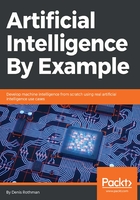
Summary
Using a McCulloch-Pitts neuron with a logistic activation function in a one-layer network to build a reward matrix for reinforcement learning shows how to build real-life applications with AI technology.
Processing real-life data often requires a generalization of a logistic sigmoid function through a softmax function, and a one-hot function applied to logits to encode the data.
This shows that machine learning functions are tools that must be understood to be able to use all or parts of them to solve a problem. With this practical approach to artificial intelligence, a whole world of projects awaits you.
You can already use these first two chapters to present powerful trajectory models such as Amazon warehouses and deliveries to your team or customers. Furthermore, Amazon, Google, Facebook, Netflix, and many others are growing their data centers as we speak. Each data center has locations with data flows that need to be calibrated. You can use the ideas given in this chapter to represent the problems and real-time calculations required to calibrate product and data flows.
This neuronal approach is the parent of the multi-layer perceptron that will be introduced in Chapter 5, Manage The Power of Machine Learning and Deep Learning. There, a shift from machine learning to deep learning will be made.
However, before that, machine learning or deep learning requires evaluation functions. No result can be validated without evaluation, as explained in Chapter 3, Apply Machine Thinking to a Human Problem. In the next chapter, the evaluation process will be illustrated with chess and a real-life situation.